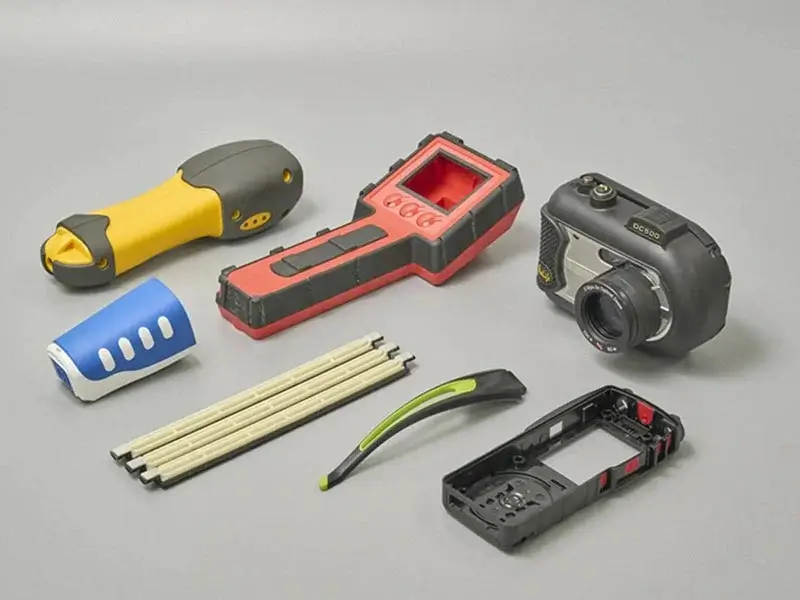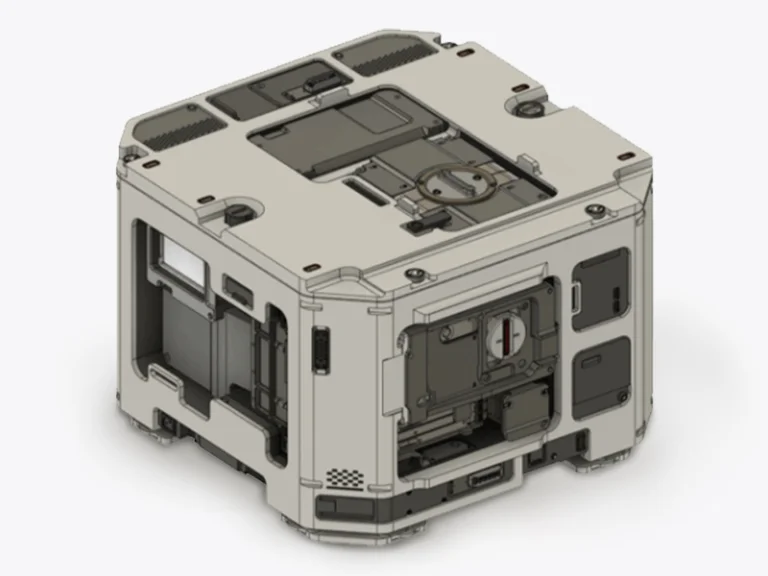Overmolding vs insert molding are two advanced manufacturing techniques used to enhance product functionality, durability, and aesthetics. While overmolding involves bonding multiple layers of materials to create a seamless, ergonomic finish, insert molding integrates pre-formed components—often metal—directly into the plastic during the molding process. Both methods serve critical roles in industries like automotive, electronics, medical devices, and consumer goods, but their applications, costs, and material compatibilities differ significantly. Understanding the insert molding vs overmolding difference is essential for selecting the right process to optimize production efficiency and product performance.

What Is Overmolding?
Overmolding is a multi-shot injection molding technique that enhances the functionality, durability, and aesthetics of a product by bonding multiple layers of material together. This process involves molding a secondary material—typically a softer thermoplastic elastomer (TPE) or rubber—over a rigid plastic or metal substrate. The result is a seamless, multi-material component with improved grip, vibration dampening, or chemical resistance.
The overmoulding service process follows a precise sequence: First, the base substrate is molded or placed into a mold. Then, a second material is injected over or around the base, forming a strong mechanical or chemical bond between the layers. This method is widely used in medical devices, consumer electronics, and ergonomic tools to provide soft-touch surfaces and enhanced usability.

What Is Insert Molding?
Insert molding is a specialized injection molding technique where pre-manufactured inserts—often metal components such as threaded fasteners, bushings, or electrical contacts—are placed into the mold cavity before molten plastic is injected. Once the plastic cools and solidifies, the insert becomes an integral part of the final molded component, creating a highly durable and functionally integrated assembly.
The injection insert molding process follows a structured approach: The metal or plastic insert is positioned inside the mold, either manually or using automation. Then, the molten plastic is injected into the cavity, encapsulating the insert and forming a strong mechanical bond. This technique is commonly used in automotive, aerospace, and electronic applications to enhance structural integrity and eliminate secondary assembly steps.

Key Differences Between Insert Molding vs Overmolding
Both overmolding and insert molding serve as advanced manufacturing techniques that enhance product functionality, durability, and aesthetic appeal. However, insert molding vs overmolding difference significantly in structural design, material compatibility, production efficiency, and industry applications.
Structural and Design Differences
Overmolding involves molding a secondary material over a rigid substrate, forming a layered structure. This process is ideal for achieving soft-touch surfaces, ergonomic grips, or protective coatings. In contrast, insert molding integrates pre-formed components—often metal inserts—directly into the molded plastic, creating a unified and structurally reinforced part. Insert molding is typically used for components requiring threaded fasteners, electrical contacts, or reinforced mechanical strength.
Material Compatibility and Bonding Strength
Overmolding requires careful selection of materials to ensure proper adhesion between the base and overmolded layers. Thermoplastic elastomers (TPEs), silicones, and certain engineered plastics are commonly used for overmolding to provide chemical or mechanical bonding. Insert molding, on the other hand, primarily involves plastic encapsulation of metal inserts, with the bonding strength relying on mechanical interlocking rather than chemical adhesion.
Production Efficiency and Cycle Time
Insert molding generally has shorter cycle times than overmolding, especially when automation is utilized for precise insert placement. Overmolding, however, may require additional molding steps, leading to longer cycle times and potentially higher costs. Additionally, insert molding can streamline assembly by integrating fasteners and eliminating secondary processes, making it more efficient for high-volume production.
Final Product Performance and Durability
Overmolding enhances product ergonomics, offering improved grip, impact resistance, and vibration dampening. It is particularly beneficial for consumer electronics, power tools, and medical devices requiring user comfort. Insert molding, by contrast, increases structural integrity, making it essential for load-bearing components, such as automotive fasteners and aerospace connectors, where mechanical stability is crucial.
Application Differences Across Industries
- Electronics – Overmolding is used for protective casings and waterproof seals, while insert molding is applied to electrical connectors and circuit board housings.
- Automotive – Insert molding is preferred for metal-plastic hybrid parts, such as engine mounts and dashboard components, whereas overmolding is used for soft-touch interiors and vibration-dampening parts.
- Medical – Overmolding creates biocompatible grips for surgical instruments, while insert molding integrates metal components in medical device housings.
- Consumer Goods – Overmolding enhances aesthetics and usability in items like toothbrush handles and power tools, while insert molding strengthens wear-resistant components such as screw housings in plastic enclosures.
How to Choose the Right Process for Your Application?
Selecting between overmolding vs insert molding depends on various factors, including part complexity, material compatibility, production volume, and industry-specific requirements. Understanding these considerations ensures optimal performance, cost-effectiveness, and manufacturing efficiency.
Part Complexity
- Overmolding is ideal for designs requiring ergonomic grips, multi-material layering, or enhanced aesthetics. It accommodates complex geometries but may demand additional processing steps, increasing costs.
- Insert molding is better suited for structurally reinforced components, particularly those integrating metal inserts for electrical conductivity or mechanical strength. It simplifies assembly but may require precise insert placement.
Material Selection
- Overmolding requires strong material adhesion, typically involving thermoplastic elastomers (TPE), liquid silicone rubber (LSR), or engineered plastics that bond well with the substrate.
- Insert molding works with a broader range of materials, especially rigid plastics like ABS, polycarbonate, and nylon, which encapsulate metal inserts without chemical bonding.
Production Volume
- High-volume manufacturing favors insert molding due to its shorter cycle times and automation potential, reducing labor costs.
- Low-to-medium volume production can benefit from overmolding, particularly for products requiring customization, soft-touch finishes, or protective coatings.
Industry-Specific Recommendations
Electronics
- Use insert molding for electrical connectors, circuit board enclosures, and components requiring precise alignment of metal and plastic.
- Use overmolding for protective casings, waterproofed seals, and shock-resistant housings in mobile devices and wearables.
Automotive
- Insert molding is essential for structural components like fasteners, dashboard panels, and hybrid metal-plastic assemblies.
- Overmolding is commonly used for soft-touch interior controls, vibration-dampening parts, and durable exterior trims.

Medical
- Insert molding is preferred for medical housings, syringe assemblies, and implantable devices requiring structural stability.
- Overmolding enhances user comfort and safety in surgical instruments, ergonomic grips, and antimicrobial-coated medical tools.
Consumer Goods
- Insert molding strengthens everyday products like power tools, kitchen appliances, and durable plastic enclosures.
- Overmolding improves grip, aesthetics, and durability in toothbrush handles, sporting goods, and handheld electronics.

Cost Analysis: Overmolding vs. Insert Molding
Cost is a critical factor when selecting between overmolding vs insert molding, as each process involves unique tooling, material, and production considerations. Understanding the financial implications helps manufacturers optimize cost-effectiveness without compromising quality or efficiency.
Overmold vs Insert Mold Costs and Setup Expenses
- Overmolding requires two sets of molds—one for the base component and another for the overmolded material. This increases initial tooling costs and setup time, making it less cost-effective for low-volume production runs.
- Insert molding generally requires a single mold with pre-loaded inserts, resulting in lower tooling costs and a simpler setup process. However, precision-engineered inserts may add complexity and increase upfront expenses.
Production Scale Impact on Cost-Effectiveness
- Overmolding becomes more economical for low-to-medium volume production, especially when customization or multi-material designs are required. However, longer cycle times due to multi-step processing can impact overall efficiency.
- Insert molding is highly scalable and well-suited for mass production. Its automation potential significantly reduces labor costs, making it the preferred choice for high-volume manufacturing.
Material Costs and Waste Reduction Considerations
- Overmolding can lead to higher material waste, especially when trimming excess material or ensuring proper adhesion between layers. However, the ability to combine soft and hard materials can improve product durability and user experience, justifying the cost.
- Insert molding optimizes material usage, as pre-formed inserts eliminate excess plastic waste. Additionally, metal inserts add strength without requiring thick plastic sections, further reducing material costs.
Case Studies and Real-World Applications
Understanding the practical implementation of overmolding service and insert molding service provides valuable insight into how these processes enhance product functionality, durability, and overall performance across various industries. Examining real-world applications can help manufacturers determine the most suitable process for their specific needs.
Overmolding Case Study: Consumer Products
Many handheld devices, such as electric toothbrushes and power tools, utilize overmolding services to apply a soft, rubberized grip over a rigid plastic base. This improves user comfort, slip resistance, and impact protection while enhancing the product’s aesthetics.
Insert Molding Case Study: Electronic Components
When evaluating insert molding vs overmolding difference, the electronics sector showcases the strengths of insert molding. Applications such as circuit board housings, power adapters, and USB connectors require precise alignment and secure encapsulation of metal components. Insert molding ensures robust electrical connections and durability, reducing the risk of failure due to mechanical stress or environmental factors.
Conclusion
Choosing between overmolding vs insert molding depends on factors like part complexity, material properties, durability, and production efficiency. Overmolding excels in ergonomic designs, protective coatings, and multi-material integration, making it ideal for consumer products and medical devices. In contrast, injection insert molding is preferred for applications requiring metal reinforcements, structural integrity, and electrical conductivity, such as in automotive and electronics. Cost, tooling, and production volume further influence the decision. Understanding the insert molding vs overmolding difference helps manufacturers optimize designs for efficiency, durability, and industry-specific needs.



